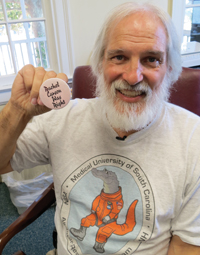|
by Dawn Brazell
Public Relations
On the surface,
crocodiles in the renowned Kruger National
Park and the oil spill along America's
Gulf Coast may not seem to have much in
common — unless you're MUSC researcher
Louis J. Guillette Jr., Ph.D.
The reproductive
endocrinologist and a developmental
geneticist is involved in studies in both
regions to figure how chemicals and
contaminants interact with the environment
in ways that impact human health. His
research is confirming just how dramatic
and far reaching these impacts can be.
 Dr.
Louis J. Guillette in South Africa.
Watch a video at Dr.
Louis J. Guillette in South Africa.
Watch a video at
http://bit.ly/Dr_Louis_Guillette_Jr.
That's a subject Guillette, director of
the Marine Biomedicine & Environmental
Sciences Center, explores in a reflective
piece published in Science magazine titled
"Life in a Contaminated World." (http://www.sciencemag.org/content/337/6102/1614.summary)
The article commemorates the 50th
anniversary of Rachel Carson's book
,"Silent Spring," that challenged thinking
that up until the early 1960s saw
pesticide use as simply a benefit to
agriculture and public health with few
detrimental consequences. Guillette
observes in the article that the book was
the start of a debate that continues to
this day on the relative benefits and
risks of not just pesticides but of all
synthetic chemicals.
 Guillette shows
off his 'Rachel Carson was right'
button. Guillette shows
off his 'Rachel Carson was right'
button.
His goal: To get
researchers, doctors and the public asking
the right questions.
"It's time. A
revolution is taking place. The new
realization is that your health is a
combination of what you inherited from mom
and dad, but also the environment you saw
from the day you were conceived. It's no
longer diseasecentric in that you have a
mutation and it's a predisposition for
disease," he said, adding that a person's
diet and lifestyle, level of stress and
exposure to chemicals that act as
endocrine disruptors all could be factors
leading to such conditions as diabetes,
obesity, cancer or infertility.
"It's not just your
genes. The idea is there is far more you
in your health than just what is inherited
from mom and dad. Your daily actions
actually have a much greater impact, not
only on your health but the health of your
children and even your grandchildren. This
potentially has a multi-generational
effect."
The reason Guillette is
so passionate and gives dozens of public
health talks every year is that he sees
the impact of how chemicals and
environmental contaminants can mimic
hormones and act as endocrine disrupters.
Endocrine disruptors
can create issues from infertility to
obesity by mimicking the actions of
naturally-occurring hormones in the body
or preventing the hormones produced. An
example is how the liver handles
excretion.
Researchers are
studying compounds that act as obesogens
that encourage the body to store fat and
re-program cells to become fat cells or
the liver to become insulin resistant.
In his wildlife biology
research for the past 20 years, Guillette
has found infertility and reproductive
issues in alligator populations from
Florida to South Carolina. Mammals use
hormones that are identical to what
reptiles use, which is why alligators and
crocodiles serve as typical research
subjects for Guillette as sentinel species
to study environmental impacts on human
health.
Into the Wild
Guillette was asked to go to South Africa
to Kruger National Park to examine why
almost half of the crocodile population
there has died off in the past two and a
half years. He went in September for a
couple of weeks to catch and test
crocodiles, getting chased by
hippopotamuses and driving through
maternity herds of elephants.
 Dr. Guillette,
who traveled with armed guides while
doing research in Kruger National Park,
took time to photograph the wonders of
the region. Dr. Guillette,
who traveled with armed guides while
doing research in Kruger National Park,
took time to photograph the wonders of
the region.
"You would come around
a bend and there would be a lion. It's
like being in Africa 100 years ago," he
said.
It was, except that this area is a
low-lying drainage basin and the
crocodiles are in trouble, as well as
catfish. "I do know crocodilians, and
there are some things that don't measure
up. Something is going on. The park is an
environmental wonderland, a place that
people come from all over the world to
visit. It resembles New Orleans as far as
environmental problems in that it's a
low-lying area susceptible to contaminants
that are transported in rivers from all
over the country."
Guillette said the
initial four year study in South Africa
will be an interesting collaboration, as
will be the three-year BP trust
fund-sponsored Gulf of Mexico research
grant. Guillette and colleagues Demetri D.
Spyropoulos, Ph.D., Satomi Kohno, Ph.D.,
and John E. Baatz, Ph.D., landed a $1.2
million grant from the Gulf of Mexico
Research Initiative to study the effects
of the Deepwater Horizon oil spill on the
gulf.
The study, "Using
Embryonic Stem Cell Fate to Determine
Potential Adverse Effects of
Petroleum/Dispersant Exposure," involves
the latest in innovative testing methods
that takes advantage of where the
researchers have set up shop.
Although the Hollings
Marine Labarotory is a National Oceanic
and Atmospheric Administration
(NOAA)-administered facility, it is a
fully cooperative enterprise with
activities governed by the five partner
organizations that include MUSC and the
National Institute of Standards and
Technology (NIST).
"It's not just great
science we're proposing, but it is also
the setting that provides us a step up
compared to lots of places. We have this
unique community that we have built and
continue to build. It validates the marine
biomedicine model we have of having a
medical school partnering with NOAA and
NIST and world-class analytical chemists
and biologists."
Into the Lab
Guillette and colleagues have worked
extensively for years trying to find out
how environmental contaminants and native
hormones influence gene expression via
steroid receptors – acting as mimics of
estrogen, progesterone and testosterone.
The question was how to screen chemicals,
in this case the petroleum and dispersant
chemicals, in a way to avoid testing a
wide array of wild animals.
Fortunately, together
with Spyropoulos, Kohno and Baatz, they
had insights based on their research
programs that could contribute a new
approach to testing environmental
chemicals.
They've developed a
technique that can take the estrogen or
progesterone receptors from the more than
40 marine animals that have been cloned
and put it into a cell with a reporter
construct so that when researchers add a
chemical, it binds to the receptor, said
Guillette.
"That is translated to
the reporter, binds to the reporter and
turns on a gene and the cell glows, and it
does it in a dose-dependent fashion. Now
you can say this chemical can be an
estrogen or a progesterone or whatever,
and determine the dose. It lets us know we
now have an active compound to study."
Spyropoulos and Baatz
also have been able to harvest lung cells
from pygmy sperm whales and make inducible
pluripotent stem cells where they took
lung cells and "drove them backwards
developmentally." Guillette said they'll
be able to take aged oil or whatever
substance they're studying and test it on
cells to see if it changes the
developmental process, so instead of
stimulating muscle cell growth, the
treated cell becomes a fat cell, for
example.
"There's a whole world
out there we realize of compounds called
obesogens. These are chemicals that in the
developing embryo instead of stimulating
the production of muscle or fiberblast
cells, it actually stimulates more fat
cells. The chemicals and contaminants in
the diet during embryonic development may
be programming that body to store more
fat."
The Gulf of Mexico
research initiative received 629
applications and MUSC was one of 19
chosen. The initiative is helping to build
a portfolio of top scientists who are
working together.
"The hope is that
although the projects are solicited as
individual investigator-driven projects,
by sharing this information, we are
building a community that is interested in
finding out what's going on. We can start
to get some idea about whether we should
be concerned and where we need to do more
work."
There are several
chemicals that are common, such as BPA
found in plastics and tri-butal-tin found
near harbors around the world, that have
been suggested to have obesogenic
activity. Guillette said their BP study
can't answer everything, but they know how
to be selective in their focus to find
those chemicals that do disrupt endocrine
cycles.
"We know that obesogens
are a critical component and that things
like estrogens and androgens are critical
for long-term and short-term fertility. We
know that glucocorticoids or stress
hormones are associated with inflammation
and immune function. We can take human
glucocorticoid receptors, whale and
alligator and fish glucocorticoid, and
line them up in different cells and test
the chemicals all at the same time. Then
we can see if the chemical potentially
interacts with the receptor that is
associated with stress and immune
function, and we can also test if it goes
across species."
The Carson
Connection
Their work builds on what Rachel Carson
believed decades ago, even without the
scientific testing methods that
researchers have today. If Carson were
alive today, he'd like to tell her thank
you and that she was right. He's proud to
be following in her footsteps.
"If I told you that in
a week you're going to get 2,000 chemicals
in your body that your grandparents never
had in their body, and we have no idea
what the health consequences are, and not
just in you – it's in your kids too. Would
you think that was good?"
The revolution happening is that
scientists from critical disciplines are
joining forces to change the way this game
is played, he said.
"We're coming together
to say as biologists, as health
professionals, as chemists, we need to
start working together. Chemists need to
start taking toxicology and health
classes, and biologists need to start
working with chemists."
It's an immense
undertaking and one still surrounded in
controversy, but Guillette sees the
science winning out.
"We're supposed to be
bright people. We're supposed to be
leaders in the world in innovation. Let's
start innovating. And you know what?
There's money in that. There's real money
in that because a proprietary chemical is
always going to make you more money than
something that's 50 years old. If that's
your vested interest, that's fine. For me,
I just want healthy kids."
Friday, Jan.
11, 2013
|



 Dr.
Louis J. Guillette in South Africa.
Watch a video at
Dr.
Louis J. Guillette in South Africa.
Watch a video at
 Dr. Guillette,
who traveled with armed guides while
doing research in Kruger National Park,
took time to photograph the wonders of
the region.
Dr. Guillette,
who traveled with armed guides while
doing research in Kruger National Park,
took time to photograph the wonders of
the region.